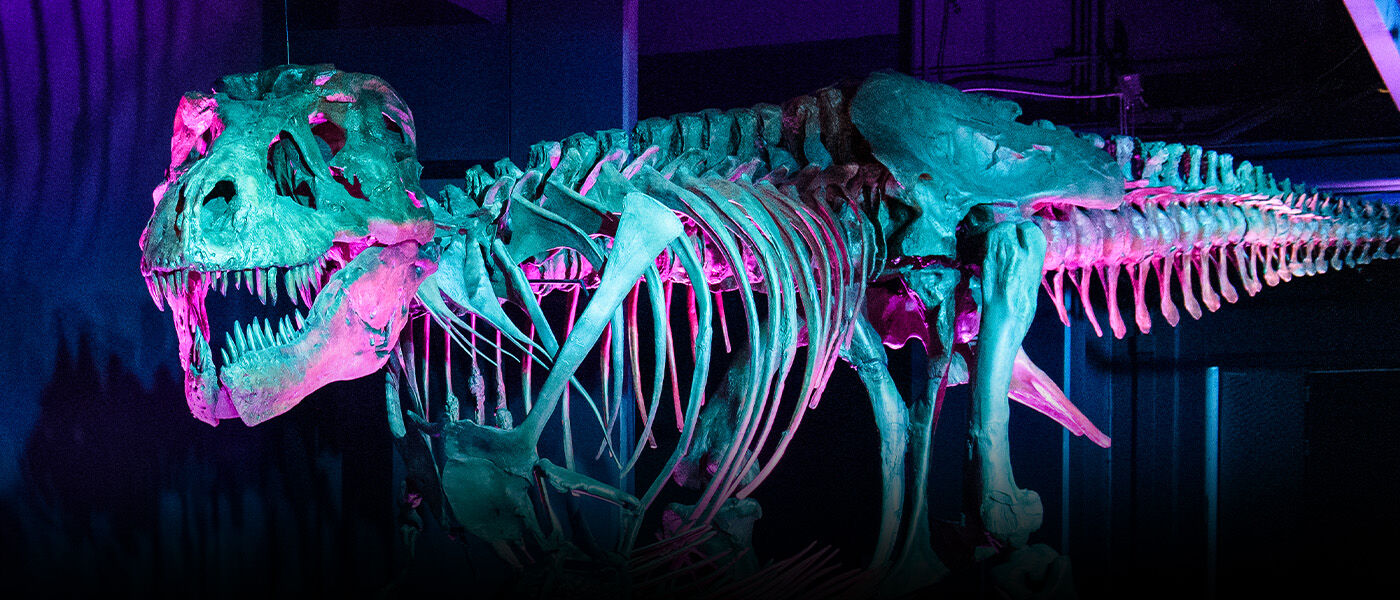Mysteries of T. rex
Have you heard of SUE the T. rex? Named after paleontologist Sue Hendrickson, this is the most complete T. rex skeleton ever found. You can see an incredible cast of this skeleton and learn more about the world of the Cretaceous in our premium exhibition, SUE: The T. rex Experience at Liberty Science Center. Paleontologists have learned a lot about prehistoric life from fossil evidence like SUE, but the exciting thing about science (and paleontology in particular,) is that we’re always learning more, as paleontologists find new fossils or examine old fossils in new ways.
In just one recent discovery, scientists counted growth rings in fossil bones long thought to belong to a teenage T. rex. The fossil turned out to be an adult, and the scientists realized it must be a smaller dinosaur, Nanotyrannus, that no one had been sure actually existed. (You can even see a cast of a Nanotyrannus skull in the SUE exhibition!)
T. rex is the largest carnivorous dinosaur that we have good fossil examples of, and we are constantly learning more about the species. Read on for some of the latest discoveries and most enduring mysteries about one of the world’s biggest predators.
T. rex fossil facts:
- T. rex is the largest carnivorous dinosaur that we have good fossil examples of.
- About 130 T. rex fossils have been found so far.
- Most of them have less than 25% of their bones.
- SUE is not just the most complete (90%) T. rex fossil ever found, but also one of the largest, estimated to weight between 8 and 10 tons.
New T. rex research:
- Since we have so few examples of T. rex, scientists reason that even larger ones than we've found probably existed. A new mathematical analysis estimates that the largest one possible—which it’s unlikely we’ll ever find—may have been 15 tons.
- Physicists recently used high-intensity x-rays from a particle accelerator to reveal rarely preserved blood vessels inside a T. rex bone. This will help them understand more about how T. rex compares to living animals.
- What were those tiny arms for? Theories include slashing at prey or holding on to mates. Scientists estimate each arm may have been able to lift about 750 pounds, which means even both together couldn’t pick up the average car. SUE’s arm recently underwent a CT scan to help paleontologists study the structure and purpose.
- Did T. rex have feathers? Some of their relatives had feathers, so some paleontologists think T. rex did too. But it might have been only sparse tufts—the few skin impression fossils we have from T. rex show scales, not feathers.
- Did they hunt alone? They might have, based on evidence for related dinosaurs, but no one has yet found fossilized tracks of a group of T. rex.
What we still don’t know about SUE:
- What are all those holes in SUE’s jaw? Paleontologists thought the holes might be evidence of a parasitic infection that’s been known to cause jaw damage in birds. But a recent comparison with other animal fossils revealed that the holes look more like an injury.
- What gender is SUE? The name comes from the paleontologist who found SUE. We actually don't know whether SUE was male or female, since fossils don't generally preserve the soft tissue of genitalia. (Researchers only know the gender of a few T. rex finds--- they knew the dinosaurs were female because the bones had calcium deposits like those found in birds and reptiles just before laying eggs.) SUE's large size doesn't help with a determination; in living theropods, or birds, sometimes males are larger, sometimes females, and sometimes they're the same size.
(c) Field Museum of Natural History - CC BY-NC 4.0
Additional fun facts:
- A lot of T. rex’s enormous head was hollow. The giant skull of T. rex had huge sinus cavities, big enough to hold about 7 gallons of snot.
- T. rex could have crushed a car with its mouth. Recent studies show that T. rex may have had a bite force of over 6 tons, which is roughly equivalent to the force of a medium-size elephant sitting down.
- T. rex probably didn’t roar. We may never know for sure, but T. rex probably made a low rumbling sound like a vibrating bass note, similar to alligators and crocodiles. It still would have been loud, audible from miles away, due to its massive size.
- T. rex had a big bite. A Tyrannosaurus rex was capable of eating 500 pounds of meat- that’s 2,000 hamburgers- in just one bite!”
- T. rex was a big baby! Well, a big toddler. At only two years old, a Tyrannosaurus rex already weighed almost 70 pounds and measured 7 feet from the tip of their nose to the tip of their tail!
- … and a gigantic teen. Scientists estimate that a T. rex put on about 5 pounds per day during its teen years, or over 1,500 pounds per year! By age 14, a T. rex weighed 4,000 pounds.
- T. rex had amazing vision. The large, forward-facing eyes of Tyrannosaurus allowed them to see as well as a modern-day hawk—no doubt a great advantage when chasing down prey.
Truly nothing compares to seeing these fossils and life-sized reconstructions in person, and you can do so at Liberty Science Center until May 25, 2025. From the smells and sounds of the world 67 million years ago, to a beautiful and educational light show on the SUE skeleton, there is plenty to uncover as you explore the exhibit. Be sure to add on your ticket to SUE: The T. rex Experience when securing your admission to LSC!
